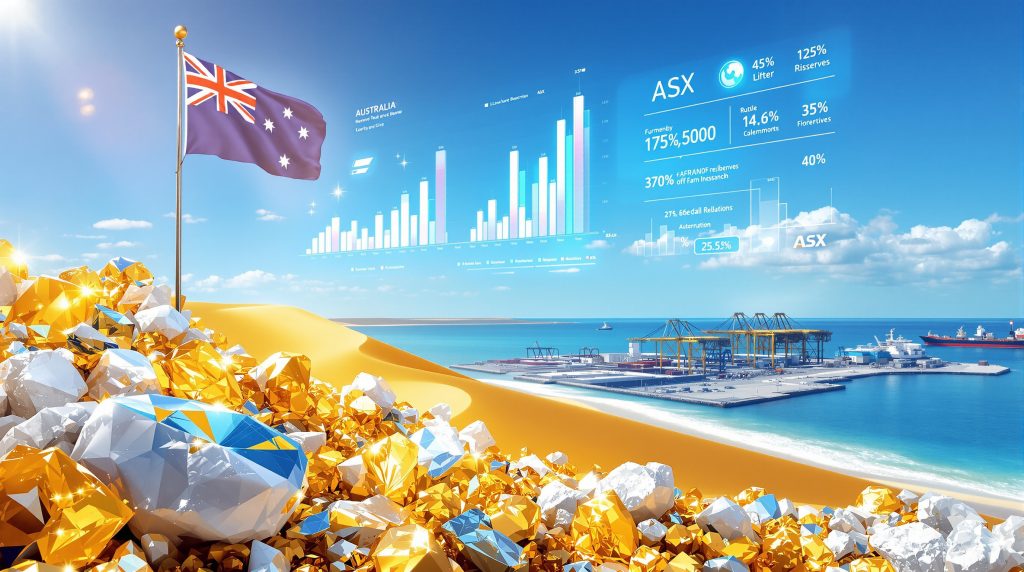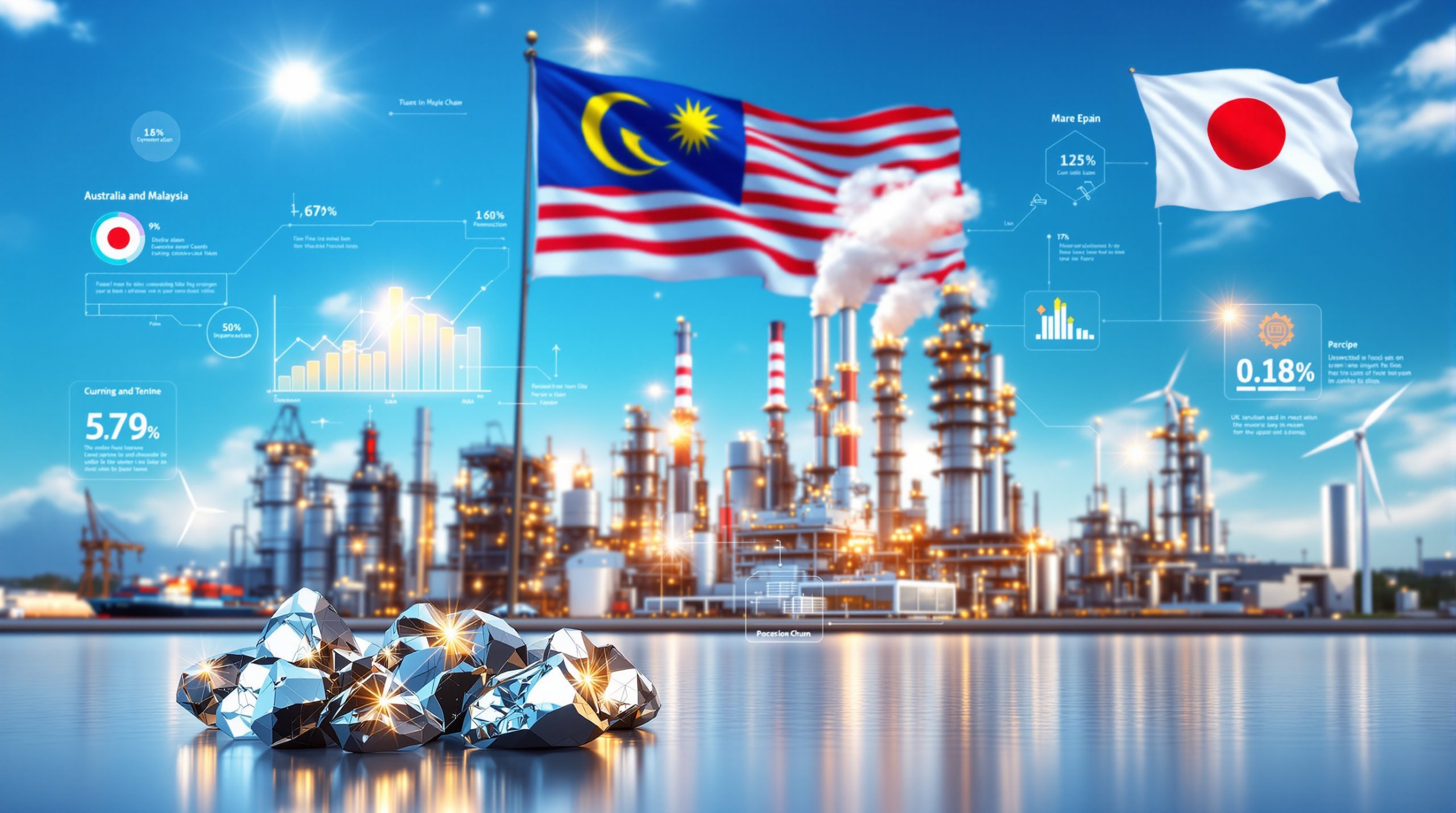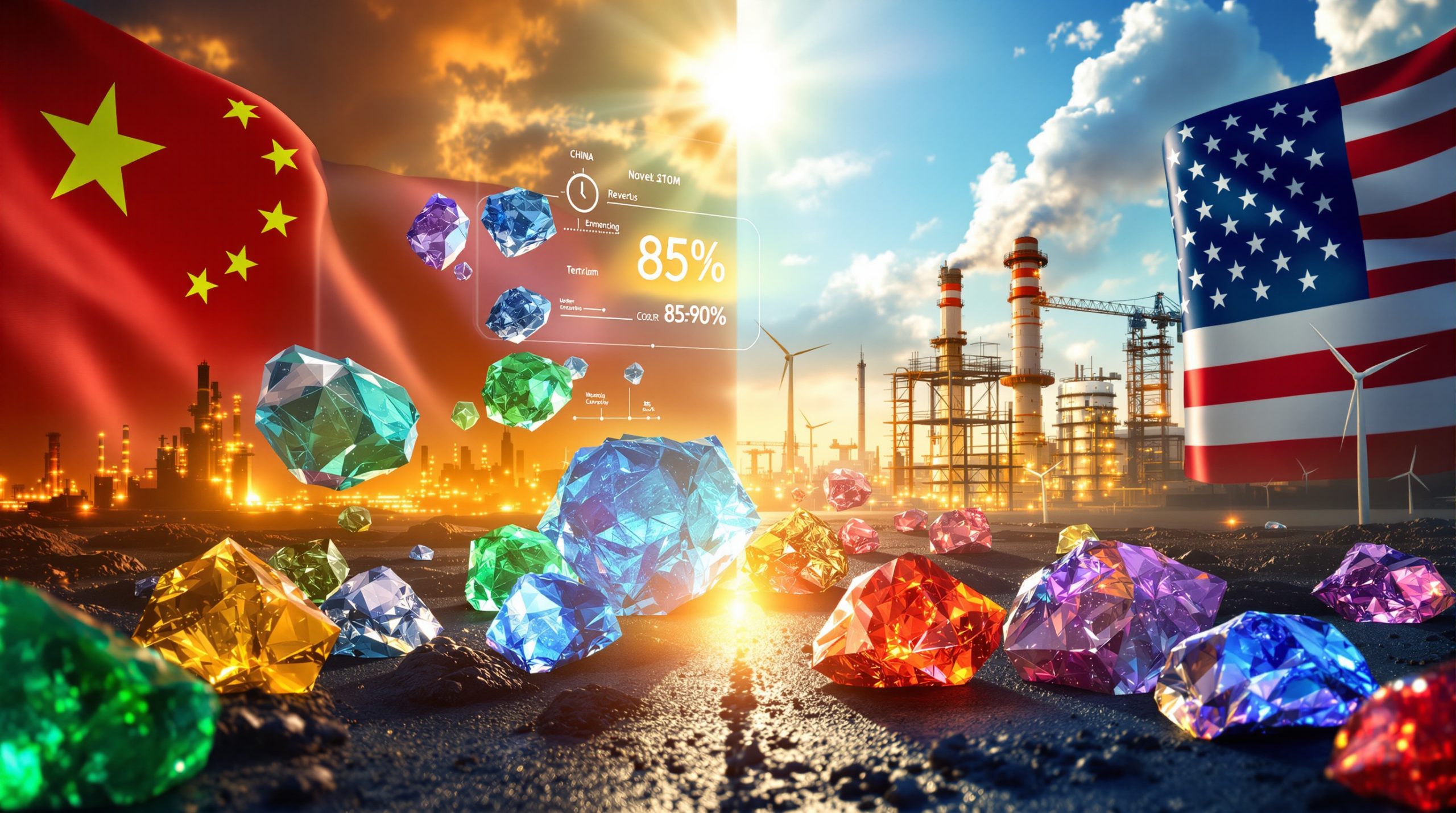Understanding the Heavy Minerals Market for Australian Investors
Mineral sands represent a specialised investment opportunity within Australia's resources sector, encompassing critical heavy minerals that power everyday products from smartphone screens to aircraft components. These materials serve as essential building blocks for industries spanning aerospace manufacturing, consumer electronics, and construction materials, positioning them at the heart of global supply chains. Furthermore, understanding these mineral beneficiation insights helps investors appreciate the value-adding potential within this sector.
The Australian mineral sands sector has evolved into a strategic powerhouse, with the continent hosting 68% of global zircon reserves and commanding significant positions across multiple heavy mineral categories. According to the Australian Bureau of Agricultural and Resource Economics and Sciences (ABARES), Australia's mineral sands industry generated approximately A$2.1 billion in export revenue during 2023, highlighting the sector's economic significance.
The Core Heavy Minerals Suite
The mineral sands complex comprises four primary heavy minerals, each serving distinct industrial applications and commanding different market valuations:
| Mineral | Titanium Content | Primary Applications | Market Position |
|---|---|---|---|
| Rutile | ~95% TiO2 | Premium pigments, titanium metal production | Premium pricing tier |
| Leucoxene | 65-90% TiO2 | High-grade pigment manufacturing | High-value segment |
| Ilmenite | 35-65% TiO2 | Bulk pigment feedstock, titanium slag | Volume commodity |
| Zircon | N/A (ZrSiO4) | Ceramics, foundry applications, electronics | Specialty markets |
These minerals form through complex geological processes spanning millions of years, creating concentrated deposits along ancient and modern coastlines. The geological formation begins when heavy minerals crystallise within igneous rocks before being liberated through weathering and transported by water systems.
Formation and Extraction of Mineral Sands Deposits
Geological Genesis
Heavy mineral deposits originate through a sophisticated natural concentration process that spans geological epochs. Initial crystallisation occurs within igneous host rocks such as granite and basalt, where these dense minerals form as accessory phases during magma cooling.
Subsequent weathering and erosion liberate these resistant minerals, which are then transported by rivers and streams toward coastal environments. Ocean currents and aeolian processes further concentrate these materials, as their higher specific gravity causes preferential deposition along shorelines.
According to Geoscience Australia's comprehensive mineral sands assessment, this natural beneficiation process can achieve heavy mineral concentrations of 15-25% in economic deposits, compared to typical background levels of 1-2% in source rocks. Moreover, these mineralogy & mining economics principles demonstrate how geological processes create economically viable deposits.
Modern Mining Methodologies
Contemporary mineral sands extraction employs two primary approaches, each suited to specific deposit characteristics and environmental conditions:
Wet Mining Operations:
• Utilises dredging systems within artificial ponds
• Employs floating concentrators for immediate gravity separation
• Requires adequate water resources and suitable hydrogeology
• Typically achieves 85-90% heavy mineral recovery rates
Dry Mining Systems:
• Deploys conventional earthmoving equipment for ore extraction
• More widely applicable across diverse geological settings
• Preferred for water-scarce locations or environmentally sensitive areas
• Generally achieves 80-85% heavy mineral recovery rates
Industry data from the Mineral Sands Association of Australia indicates that approximately 60% of current Australian production utilises dry mining techniques, reflecting the versatility and cost-effectiveness of this approach across varying deposit types.
Market Dynamics Driving Global Demand
Titanium Minerals: The Pigment Powerhouse
The titanium minerals market represents a US$4.5 billion annual industry, with pigment manufacturing consuming approximately 90% of global production. Titanium dioxide pigment provides the essential white, opaque properties required across multiple industrial applications. Additionally, these materials form part of the broader critical raw materials supply chain that supports various manufacturing sectors.
Primary Demand Drivers:
• Global construction activity requiring architectural coatings
• Automotive production demanding high-performance paints
• Packaging industries utilising titanium dioxide in plastics and paper
• Consumer goods manufacturing incorporating whitening agents
The remaining 10% of titanium mineral consumption supports speciality applications including aerospace components, medical implants, and high-performance sporting equipment. According to the International Titanium Association, global titanium metal demand has grown at a compound annual growth rate of 4.2% over the past decade.
Zircon: Ceramics and Beyond
Zircon consumption centres primarily on ceramic tile manufacturing, which accounts for approximately 50% of global demand. China dominates both production and consumption within this sector, driven by domestic construction preferences and export manufacturing capacity.
Emerging Application Sectors:
• Advanced electronics requiring high-temperature components
• Automotive catalytic converter manufacturing
• Nuclear industry applications utilising zircon's neutron absorption properties
• Speciality chemical production for industrial processes
Market research from Wood Mackenzie indicates that zircon demand in electronics applications has grown by 8.3% annually since 2020, driven by 5G infrastructure deployment and electric vehicle adoption.
Australia's Global Resource Dominance
Reserve Distribution and Production Leadership
Australia maintains commanding positions across multiple mineral sands categories, establishing the continent as a strategic supplier to global markets. The latest United States Geological Survey (USGS) data reveals Australia's dominant reserve position:
Global Zircon Reserves (2024):
| Country | Reserves (Mt) | Global Share |
|---|---|---|
| Australia | 42 | 68% |
| South Africa | 8 | 13% |
| India | 4 | 6% |
| Other Nations | 8 | 13% |
Australian Mineral Sands Reserve Holdings:
• Zircon: 42Mt representing 68% of identified global reserves
• Rutile: 28Mt accounting for 60% of global reserves
• Ilmenite: 250Mt comprising 32% of worldwide reserves
Production Economics and Value Creation
The Australian mineral sands sector generated A$2.4 billion in export revenue during 2023, according to the Australian Bureau of Statistics. This production supports a downstream value chain worth an estimated US$15 billion globally in titanium dioxide pigment manufacturing alone.
Current production levels from Australian operations include:
• Ilmenite: 850,000 tonnes annually
• Rutile: 180,000 tonnes annually
• Zircon: 550,000 tonnes annually
• Leucoxene: 45,000 tonnes annually
Emerging Supply-Demand Imbalances
Structural Market Tightening
Independent market analysis indicates developing supply constraints across key mineral sands categories, creating potential investment opportunities for well-positioned producers. Research from industrial minerals consultancy TZMI forecasts significant supply-demand imbalances emerging over the next decade. These trends align with broader mineral discovery trends affecting resource availability.
Projected Market Dynamics:
• Ilmenite shortage anticipated within 3-4 years as existing mines deplete
• Zircon demand growing 3% annually while production capacity declines 5% per annum
• Rutile markets remaining structurally tight with limited new supply additions
Post-Pandemic Market Resilience
The mineral sands sector demonstrated notable resilience during 2020-2021 economic disruptions, with pricing erosion proving less severe than previous downturns. Government infrastructure stimulus programmes, particularly in the United States and China, supported sustained consumption levels.
Market Stability Factors:
• Controlled production levels preventing oversupply conditions
• Reduced customer inventory levels creating restocking demand
• Continued construction and manufacturing activity in key markets
• Strategic mineral classification driving supply chain diversification initiatives
Leading ASX-Listed Mineral Sands Opportunities
Tier 1: Established Production Leaders
Iluka Resources (ASX: ILU)
Iluka Resources represents the premier ASX-listed mineral sands investment opportunity, operating as the world's largest zircon producer through its Jacinth-Ambrosia operation in South Australia. The company's Sierra Rutile operation in West Africa constitutes the globe's largest rutile mine.
According to company reports, Iluka has generated A$2.4 billion in free cash flow over the past decade, demonstrating the cash-generative nature of established mineral sands operations. The company's diversified asset portfolio spans Australia, the United States, and West Africa, providing geographic risk mitigation.
Key Operational Metrics:
• Zircon production: 285,000 tonnes annually across all operations
• Rutile production: 195,000 tonnes annually from Sierra Rutile
• Mine life: 15+ years across current operating assets
• Market position: Controls approximately 25% of global zircon supply
Tier 2: Advanced Development Projects
Strandline Resources (ASX: STA)
Strandline Resources has advanced its Coburn project to construction-ready status, with a definitive feasibility study confirming an NPV of A$705 million at current commodity pricing assumptions. The project has secured 72% of forecast revenue under binding offtake agreements with international customers.
The company secured a A$150 million loan facility from the Northern Australia Infrastructure Facility (NAIF) in 2021, providing the foundation for project development. Extension scenarios indicate potential mine life expansion to 37.5 years, increasing NPV estimates to A$825 million.
Sheffield Resources (ASX: SFX)
Sheffield Resources has progressed its Thunderbird project through a strategic joint venture with Chinese steel producer Yansteel, which acquired a 50% interest for A$130.1 million in 2021. This fully-permitted development in Western Australia's far north targets first production by 2024.
The joint venture structure provides Sheffield with development funding while maintaining operational control and marketing flexibility for its 50% production share.
Tier 3: Emerging Development Opportunities
Base Resources (ASX: BSE)
Base Resources operates the Kwale mine in Kenya, producing rutile, ilmenite, and zircon from coastal deposits. The company's Toliara project in Madagascar represents a significant development opportunity with ore reserves of 586Mt at 6.5% heavy minerals, supporting an initial 33-year mine life.
COVID-19 impacts delayed the final investment decision for Toliara, with current timelines targeting development commencement in 2025, subject to regulatory approvals and financing completion.
Image Resources (ASX: IMA)
Image Resources operates the Boonanarring mine north of Perth, which achieved record production levels during 2023. The unique deposit grades 8.9% heavy minerals with 27.5% zircon content, providing premium revenue characteristics compared to typical mineral sands operations.
The company's Project MORE exploration programme targets two-year reserve life extension through resource conversion within a 10km radius of existing processing infrastructure.
Market Pricing Mechanisms and Outlook
Opaque Pricing Structure
Unlike exchange-traded base metals, mineral sands pricing occurs through direct negotiations between producers and end-users, creating information asymmetries but enabling long-term contract stability. This bilateral pricing system typically involves annual negotiations based on market fundamentals and supply-demand dynamics.
Current Pricing Indicators (Q4 2024, USD/tonne FOB Australia):
• Rutile (95% TiO2): US$1,150-1,250
• Zircon concentrate: US$1,380-1,450
• Ilmenite (54% TiO2): US$275-295
• Leucoxene (70% TiO2): US$420-480
Price Forecasting and Market Outlook
Independent analysis from TZMI suggests pricing stability through 2025-2026, with zircon potentially strengthening to US$1,540/tonne by 2025 before moderating. Rutile prices may experience gradual declines from current levels, while ilmenite could strengthen to US$290/tonne by 2025.
Market research indicates that supply constraints may support premium pricing for high-grade products, particularly rutile and premium zircon concentrates, as new mine development struggles to match depletion rates from existing operations. Furthermore, comprehensive market data can be found through mineral sands market indices that track pricing trends.
Investment Risk Considerations
Market-Specific Risk Factors
Demand Concentration Risks:
• Heavy dependence on Chinese ceramic tile manufacturing sector
• Economic cycles affecting construction and automotive end-markets
• Potential material substitution by alternative technologies
• Currency fluctuation impacts on international sales
Operational Challenge Areas:
• Complex environmental permitting processes requiring multiple approvals
• Water availability constraints for wet mining operations
• Transportation infrastructure requirements for remote deposits
• Regulatory changes affecting mining and export operations
Geographic and Political Considerations
Several ASX-listed mineral sands companies operate internationally, creating exposure to additional risk factors including political instability in developing nations, foreign exchange fluctuations, and evolving export regulations in key jurisdictions.
Companies with significant African operations face particular challenges related to infrastructure development, regulatory compliance, and political risk management. Investors should carefully evaluate geographic exposure when assessing mineral sands investments.
Long-Term Growth Catalysts
Technology-Driven Demand Expansion
Emerging applications beyond traditional pigment and ceramic markets are creating new consumption categories with higher growth potential. Electric vehicle manufacturing requires specialised coatings and components utilising mineral sands products. These developments form part of the evolving critical minerals framework supporting energy transition initiatives.
High-Growth Application Sectors:
• Electric vehicle battery and component manufacturing
• Solar panel and wind turbine infrastructure development
• Advanced aerospace materials for next-generation aircraft
• Medical device innovation requiring biocompatible materials
Supply Chain Diversification Imperatives
Geopolitical tensions and supply chain resilience concerns are driving Western nations to diversify critical mineral sources away from concentrated suppliers. This trend potentially benefits Australian producers through strategic partnerships and preferential trade arrangements.
The United States Department of Defense has classified titanium as a critical mineral, supporting domestic sourcing initiatives that could benefit Australian suppliers with established market positions.
Investment Strategy Considerations
Portfolio Construction Approaches
Mineral sands stocks on the ASX offer investors exposure to essential industrial materials with defensive characteristics and growth potential. The sector's mature technology base and established markets provide stability compared to emerging commodity sectors. Consequently, detailed analysis of ASX mining opportunities can inform strategic investment decisions.
Investment Tier Framework:
• Tier 1: Established producers with diversified operations and consistent cash generation
• Tier 2: Advanced development projects with completed feasibility studies and secured financing
• Tier 3: Early-stage exploration and development opportunities with resource upside potential
Market Cycle Positioning
Historical analysis indicates mineral sands markets follow construction and industrial production cycles, with demand typically leading economic recovery by 6-12 months. Current supply constraints may create favourable conditions for producers entering the next expansion phase.
Market research suggests the optimal investment entry point occurs during periods of controlled supply and strengthening end-market fundamentals, conditions that appear to be developing across multiple mineral sands stocks on the ASX categories.
Risk Management Considerations
Successful mineral sands investing requires careful assessment of operational risks, market exposure, and development timelines. Companies with established production streams typically offer more predictable returns, whilst development-stage projects provide greater upside potential alongside higher execution risks.
Geographic diversification across multiple producing regions can mitigate country-specific risks, particularly for investors considering exposure to operations in developing nations. However, investors must balance this diversification against operational complexity and management expertise requirements.
Disclaimer: This article contains forward-looking statements and market forecasts based on current industry analysis. Mineral sands investments carry risks including commodity price volatility, operational challenges, and regulatory changes. Investors should conduct independent research and consider professional advice before making investment decisions. Past performance does not guarantee future results.
Looking to Capitalise on Australia's Mineral Sands Dominance?
Discovery Alert's proprietary Discovery IQ model delivers instant notifications when ASX mineral sands companies announce significant discoveries, helping investors identify actionable opportunities before broader market recognition. Start your 30-day free trial today and gain the market-leading edge needed to navigate Australia's A$2.1 billion mineral sands sector with confidence.




